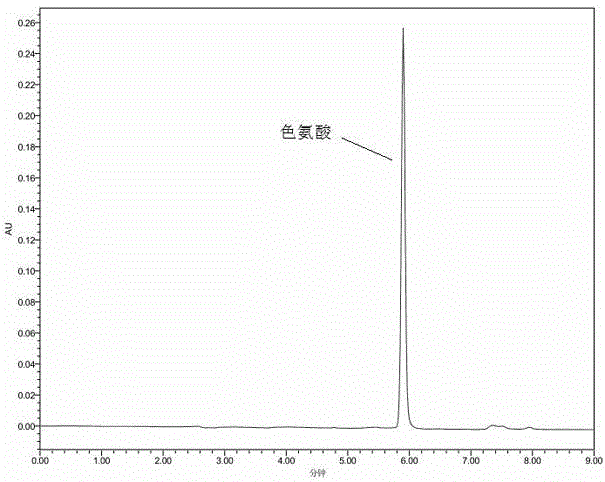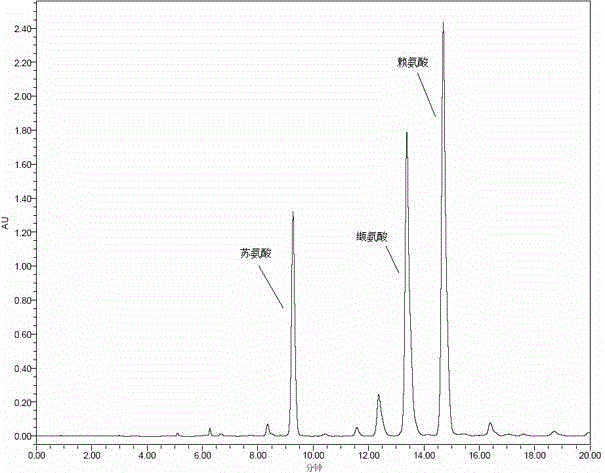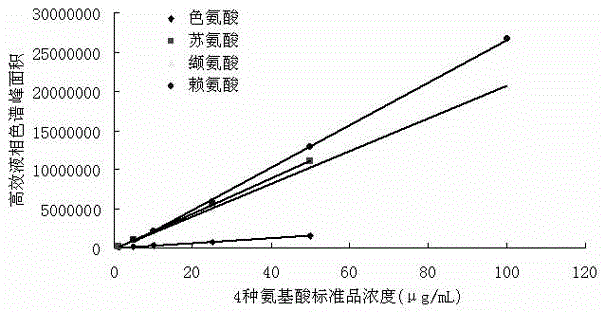Method for analyzing protein adulteration in dairy products
An analysis method and technology of dairy products, applied in the field of analysis of protein adulteration in dairy products, can solve problems such as high detection cost, difficulty in obtaining detection resources for grassroots detection departments, non-dairy protein adulteration, etc., to meet the needs of safety control , Wide market application prospects, high sensitivity effect
- Summary
- Abstract
- Description
- Claims
- Application Information
AI Technical Summary
Problems solved by technology
Method used
Image
Examples
Embodiment 1
[0041] Example 1 Milk sample protein simulation adulteration discrimination
[0042] (1) Accurately weigh 0.010g each of tryptophan, threonine, valine, and lysine standard substances, dissolve them in 0.01mol / L HCl solution and dilute to 10mL, and prepare a standard stock of 1000μg / mL liquid in a volumetric flask. Prepare standard solutions with tryptophan concentrations of 1, 5, 10, 25, and 50 μg / mL with tryptophan standard stock solutions; prepare threonine, valine, and lysine standard stock solutions to prepare threonine, Valine, lysine mixed standard solution, so that the concentrations of threonine were 2, 10, 20, 50, 100 μg / mL; mL; derivatize the mixed standard solution of threonine, valine, and lysine; draw 10 μL of the derivative solution of tryptophan standard solution and the mixed standard solution of threonine, valine, and lysine, respectively, and inject High-performance liquid chromatography is analyzed, obtains the peak area of high-performance liquid chro...
Embodiment 2
[0063] Example 2 Milk powder sample protein simulation adulteration discrimination
[0064] (1) Accurately weigh 0.010g each of tryptophan, threonine, valine, and lysine standard substances, dissolve them in 0.01mol / L HCl solution and dilute to 10mL, and prepare a standard stock of 1000μg / mL liquid in a volumetric flask. Prepare standard solutions with tryptophan concentrations of 1, 5, 10, 25, and 50 μg / mL with tryptophan standard stock solutions; prepare threonine, valine, and lysine standard stock solutions to prepare threonine, Valine, lysine mixed standard solution, so that the concentrations of threonine were 2, 10, 20, 50, 100 μg / mL; mL; derivatize the mixed standard solution of threonine, valine, and lysine; draw 10 μL of the derivative solution of tryptophan standard solution and the mixed standard solution of threonine, valine, and lysine, respectively, and inject High-performance liquid chromatography is analyzed, obtains the peak area of high-performance liqu...
PUM
| Property | Measurement | Unit |
|---|---|---|
| wavelength | aaaaa | aaaaa |
Abstract
Description
Claims
Application Information
 Login to View More
Login to View More - R&D
- Intellectual Property
- Life Sciences
- Materials
- Tech Scout
- Unparalleled Data Quality
- Higher Quality Content
- 60% Fewer Hallucinations
Browse by: Latest US Patents, China's latest patents, Technical Efficacy Thesaurus, Application Domain, Technology Topic, Popular Technical Reports.
© 2025 PatSnap. All rights reserved.Legal|Privacy policy|Modern Slavery Act Transparency Statement|Sitemap|About US| Contact US: help@patsnap.com



